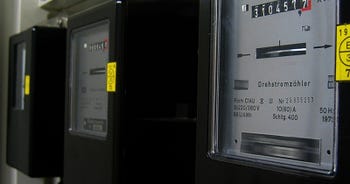What Are Smart Thermostats and can they save me money?
With energy bills on the rise, it’s not surprising that businesses are actively trying to reduce their energy consumption in any way possible.
Whether you’re a small business just trying to make it off the ground or a well-established large business looking for ways to save money, smart thermostats can be a great investment in your business's future.
From the advantages of installing a smart thermostat for your business to how much it costs, learn more about what they are with this handy Bionic guide.
What are smart thermostats?
Smart thermostats are a great way of monitoring your business's gas and electricity usage and heating your business intelligently. This little piece of kit connects your heating system to the internet — allowing it to be controlled by a phone, tablet, smart speaker or another internet-connected device.
Unlike a smart meter, you can install a smart thermostat yourself, so it doesn’t matter who provides your business energy.

What can a smart thermostat do?
Smart thermostats allow you to create automatic and programmable temperature settings based on things like:
- Your business's daily schedule
- The weather conditions
- Heating and cooling needs
- Since you can put the heating on at the tap of a button, a smart thermostat helps to save money, time and energy.
Take a look at our handy guide to find out how much energy your business consumes on average.
How does a smart thermostat work?
To understand how a smart thermostat works, you’ll first need to know how a regular thermostat works.
A thermostat works by reading or sensing the ambient temperature of your business location and then switching the boiler on or off to keep it at the temperature you’ve set.
A smart thermostat works in a similar way, but it also connects to WiFi. This way, you can change any of the thermostat's settings remotely using an app you’ll have to download to a smart device.
What’s the difference between a smart thermostat and a programmed thermostat?
A programmable thermostat allows you to set an automatic heating schedule for a certain number of days — usually up to 7. As well as the obvious gain in convenience, the aim of programmable thermostats is to save you money as you can automatically set them to turn on at the same time every day when you open up your business.
But, be aware that some programmable thermostats have limited scheduling features, so it may only allow you to set one daily schedule that repeats every seven days, or you may have a limit on the number of programs you can set in a day. While you can override these automatic programs by adjusting the heating manually, it takes away the benefit of having a programmable thermostat in the first place.
How much does a smart thermostat cost?
On average, a smart thermostat can cost anywhere between £100 and £250 in the UK, depending on the make, model, features and installation costs.
Most makers will offer installation; however, certain brands on the market don’t require the help of a professional — meaning you can save anywhere up to £100 if you’re DIY savvy.
Can a smart thermostat help you save money?
Thermostats aren’t just good for the environment — they’re also great for your business electricity bill.
Using the manual and energy-saving tips that smart thermostats provide is a great way to accurately zero in on the correct temperature zones to help save money. Since they give precise and up-to-date information, you can see how much energy you use, when you use it most and at what times.
And, with energy bills on the rise, it’s no wonder that more and more businesses are turning to smart thermostats to regulate their spending.
What are the advantages of a smart thermostat?
Since smart thermostats can be pricier than traditional ones, it’s helpful to know some of their advantages.
1. Remotely control from your phone
Whichever smart thermostat you buy will come with a branded app that you’ll have to download onto your phone or tablet. As a result, you can check and control the thermostat anywhere you have data or a WiFi connection and make changes accordingly.
These thermostats are quite helpful if you want to make sure that the office is warm before your staff arrive on a cold morning!
2. App-based scheduling
In addition to the long-distance control, a smart thermostat also allows you to create a heating or cooling schedule based on your habits directly in the app. This is easier than fiddling around with buttons on a control panel and allows you to create a more in-depth temperature management system week to week (if applicable).
3. Track energy use
Once you’ve set up your smart thermostat, it will provide you with energy reports based on how much power your business uses. It’ll also include information on how your energy usage has changed over time and how much this is likely going to/or has already cost.
As a result, these reports are typically bundled with tips and tricks on how to lower your energy usage, seasonal advice and much more.
4. Compatibility with other smart devices
Smart thermostat platforms continuously introduce new ways for us to interact. Most recently, its compatibility to pair with other smart devices — such as Google Home and Alexa — means you no longer have to control with just your phone; instead, you can voice command to turn the heating on and make changes on the spot!
Smart humidifiers and air purifiers can even be controlled with a thermostat if they’re on compatible platforms!
5. Long-term learning
The Nest Planet Protect Learning Thermostat states that it “adapts as your life changes”, and with as little as one week's usage, it can program itself. In combination with its sensors, it can also “learn” when people are most active and when the heating/cooling systems need to be on and will change its own systems accordingly.
What happens to a smart thermostat when the WiFi goes down?
Contrary to popular belief, smart thermostats aren’t completely dependent on WiFi and can continue functioning without an internet connection.
You won’t be able to control the thermostat through your phone, tablet or smart device without WiFi, but you can still make changes to the temperature through the physical smart thermostat device itself.
Do smart thermostats work with any smartphone?
Smart thermostats will work with almost any smartphone, so long as you can download and install apps on it. iOS and Android devices are the most popular operating systems. If you use either of these operating systems, it should be fairly easy to connect with your smart thermostat.
Can I install a smart thermostat myself?
Unlike smart meters, you can install a smart thermostat yourself. However, most brands, like Nest, recommend that one of their professionals install their systems if you want it done correctly.
If you break the thermostat while installing it, some brands may not give you a replacement or help with sourcing replacement parts because you didn’t have it installed by a professional, therefore it’s voided your warranty.
Get your business set with Bionic
Wrapping your head around smart thermostats and what they can mean for your business can sometimes feel like a challenge. The most important thing to know is that they’re great for saving your business money, reducing your carbon footprint and helping your business take the next step in its future.
If you need more help understanding your energy bills or anything energy-related, head over to our energy guide page for more information. Or, get in touch today with the Bionic team to discuss your needs or get more information on business energy, including business electricity and business gas.








